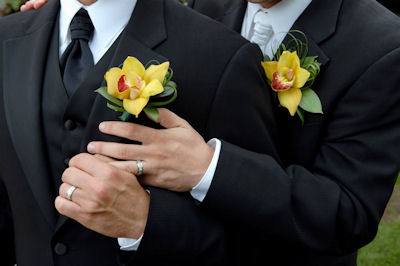Same Sex Ceremonies - Negotiating the Gendered Nature of Ceremony Traditions
Categories: | Inclusive Weddings | Wedding Ceremony | Wedding Traditions |
 I
wrote this article way back in 2005. At that time, a
year after John Howard had deliberately moved to cut
off at the knees a High Court Case in which two
couples were petitioning to have their overseas
marriages recognised, all that was available to same
sex couples in Australia was a non-legal commitment
ceremony.
I
wrote this article way back in 2005. At that time, a
year after John Howard had deliberately moved to cut
off at the knees a High Court Case in which two
couples were petitioning to have their overseas
marriages recognised, all that was available to same
sex couples in Australia was a non-legal commitment
ceremony. All couples, regardless of gender, can now legally marry in Australia. So it is timely to revisit the topic.
While a [same sex] commitment ceremony is based on a traditional wedding, so many traditional wedding customs are inherently based on the mixed gender of the couple. There are a number of ways in which this can be addressed for same sex couples.
I do not believe it is appropriate for the partners
each to take on a heterosexual role. Instead, I
suggest that you assign individual customs/traditions
to the partners instead of entire roles (customs
includes who enters first/last, who stands on the
right, who takes the first vow, and so on), and also
assign customs in duplicate (for example, both
partners walk down the aisle instead of just one).
In planning the ceremony, you can start with a blank sheet. There are no hard-and-fast rules that everyone believes you MUST adhere to (well, apart from the ring and the always-important kiss after the declaration, neither of which is a rule but most guests would be disappointed if you skip them). As a result, you can do whatever is authentic to you as a couple. You can have whoever you want stand up with you, and you can enter the ceremony space accompanied by whomever you wish.
In terms of your attendants/supporters, there is already a precedent for mixed genders in straight wedding parties. Because more and more people are having the people they are close to stand up with them, rather than sticking with the traditional gender divide, we are starting to see a neutralisation of the gender of the roles by referring to the matron/maid of honour/chief bridesmaid and best man as "honour attendants" and bridesmaids and groomsmen as "attendants".
The gender bias in straight ceremonies is most obvious in the way that a traditional wedding party's appearance derives all of its flair and colour from the bride and the bridesmaids. The groomsmen, on the other hand, dress in staid black or grey and the identically dressed groom is separated from them solely by his style of boutonnière, or maybe a slightly different tie or vest. While, for lesbian couples, the choices are more varied, if a gay couple applies the traditional dress code to all the men, the party lacks a focal point because the grooms are then virtually indistinguishable from their attendants. Colour, style, boutonnières, and type of dress can all be used to bring some colour and differentiation into the wedding party's attire.
One of the decisions that needs to be made and conveyed early to your celebrant, is how you want to be referred to and addressed during the ceremony. My advice, stick with your names. Just as your relationship is unique and special, so are your names. Groom and Groom or Bride and Bride can be awkward (though Husband and Husband or Wife and Wife is fantastic), Partners has a nice gender-free inclusive ring, as does Partners in Marriage, and for heavens sake, avoid stereotypical awkwardness caused by assigning a "male" role and a "female" role. I sincerely hope I never come across "Bride and Groomette" ever again. Once was enough!Thanks for reading!
